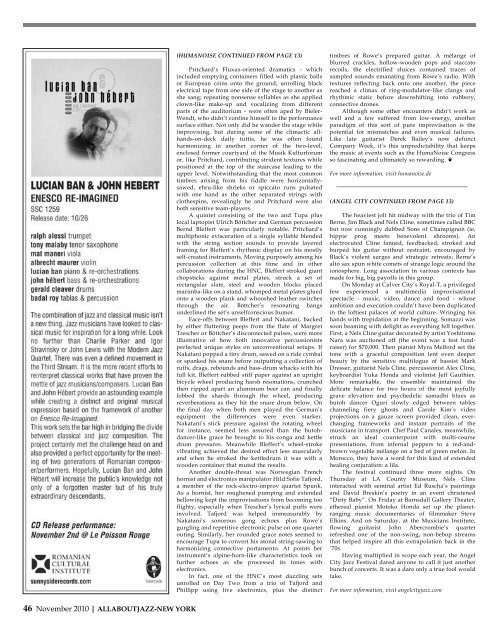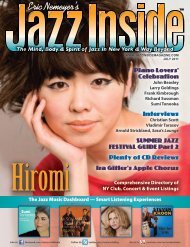AllAboutJazz-New York www.aaj-ny.com - Jazz Singers.com
AllAboutJazz-New York www.aaj-ny.com - Jazz Singers.com
AllAboutJazz-New York www.aaj-ny.com - Jazz Singers.com
You also want an ePaper? Increase the reach of your titles
YUMPU automatically turns print PDFs into web optimized ePapers that Google loves.
46 November 2010 | ALLABOUTJAZZ-NEW YORK<br />
(HUMANOISE CONTINUED FROM PAGE 13)<br />
Pritchard’s Fluxus-oriented dramatics - which<br />
included emptying containers filled with plastic balls<br />
or European coins onto the ground; unrolling black<br />
electrical tape from one side of the stage to another as<br />
she sang; repeating nonsense syllables as she applied<br />
clown-like make-up and vocalizing from different<br />
parts of the auditorium - were often aped by Bieler-<br />
Wendt, who didn’t confine himself to the performance<br />
surface either. Not only did he wander the stage while<br />
improvising, but during some of the climactic allhands-on-deck<br />
daily tuttis, he was often found<br />
harmonizing in another corner of the two-level,<br />
enclosed former courtyard of the Musik Kulturforum<br />
or, like Pritchard, contributing strident textures while<br />
positioned at the top of the staircase leading to the<br />
upper level. Notwithstanding that the most <strong>com</strong>mon<br />
timbres arising from his fiddle were horizontallysawed,<br />
ehru-like shrieks or spiccato runs pulsated<br />
with one hand as the other separated strings with<br />
clothespins, revealingly he and Pritchard were also<br />
both sensitive team-players.<br />
A quintet consisting of the two and Tupa plus<br />
local laptopist Ulrich Böttcher and German percussion<br />
Bernd Bleffert was particularly notable. Pritchard’s<br />
multiphonic evisceration of a single syllable blended<br />
with the string section sounds to provide layered<br />
framing for Bleffert’s rhythmic display on his mostly<br />
self-created instruments. Moving purposely among his<br />
percussion collection at this time and in other<br />
collaborations during the HNC, Bleffert stroked giant<br />
chopsticks against metal plates, struck a set of<br />
rectangular slate, steel and wooden blocks placed<br />
marimba-like on a stand, whomped metal plates glued<br />
onto a wooden plank and whooshed leather switches<br />
through the air. Böttcher’s resonating bangs<br />
underlined the set’s unselfconscious humor.<br />
Face-offs between Bleffert and Nakatani, backed<br />
by either fluttering peeps from the flute of Margret<br />
Trescher or Böttcher’s disconnected pulses, were more<br />
illustrative of how both innovative percussionists<br />
perfected unique styles on unconventional setups. If<br />
Nakatani popped a ti<strong>ny</strong> drum, sawed on a ride cymbal<br />
or spanked his snare before outputting a collection of<br />
ruffs, drags, rebounds and bass-drum whacks with his<br />
full kit, Bleffert rubbed stiff paper against an upright<br />
bicycle wheel producing harsh resonations, crunched<br />
then ripped apart an aluminum beer can and finally<br />
lobbed the shards through the wheel, producing<br />
reverberations as they hit the snare drum below. On<br />
the final day when both men played the German’s<br />
equipment the differences were even starker.<br />
Nakatani’s stick pressure against the rotating wheel<br />
for instance, seemed less assured than the butohdancer-like<br />
grace he brought to his conga and kettle<br />
drum pressures. Meanwhile Bleffert’s wheel-stroke<br />
vibrating achieved the desired effect less muscularly<br />
and when he stroked the kettledrum it was with a<br />
wooden container that muted the results.<br />
Another double-threat was Norwegian French<br />
hornist and electronics manipulator Hild Sofie Tafjord,<br />
a member of the rock-electro-improv quartet Spunk.<br />
As a hornist, her roughened pumping and extended<br />
bellowing kept the improvisations from be<strong>com</strong>ing too<br />
flighty, especially when Trescher’s lyrical puffs were<br />
involved. Tafjord was helped immeasurably by<br />
Nakatani’s sonorous gong echoes plus Rowe’s<br />
gurgling and repetitive electronic pulse on one quartet<br />
outing. Similarly, her rounded grace notes seemed to<br />
encourage Tupa to convert his atonal string-sawing to<br />
harmonizing connective portamento. At points her<br />
instrument’s alpine-horn-like characteristics took on<br />
further echoes as she processed its tones with<br />
electronics.<br />
In fact, one of the HNC’s most dazzling sets<br />
unrolled on Day Two from a trio of Tafjord and<br />
Phillipp using live electronics, plus the distinct<br />
timbres of Rowe’s prepared guitar. A mélange of<br />
blurred crackles, hollow-wooden pops and staccato<br />
recoils, the electrified sluices contained traces of<br />
sampled sounds emanating from Rowe’s radio. With<br />
textures reflecting back onto one another, the piece<br />
reached a climax of ring-modulator-like clangs and<br />
rhythmic static before downshifting into rubbery,<br />
connective drones.<br />
Although some other encounters didn’t work as<br />
well and a few suffered from low-energy, another<br />
paradigm of this sort of pure improvisation is the<br />
potential for mismatches and even musical failures.<br />
Like late guitarist Derek Bailey’s now defunct<br />
Compa<strong>ny</strong> Week, it’s this unpredictability that keeps<br />
the music at events such as the HumaNoise Congress<br />
so fascinating and ultimately so rewarding. K<br />
For more information, visit humanoise.de<br />
(ANGEL CITY CONTINUED FROM PAGE 13)<br />
The heaviest jolt hit midway with the trio of Tim<br />
Berne, Jim Black and Nels Cline, sometimes called BBC<br />
but now cunningly dubbed Sons of Champignon (ie,<br />
hippie prog meets benevolent shrooms). An<br />
electrocuted Cline fanned, feedbacked, stroked and<br />
burped his guitar without restraint, encouraged by<br />
Black’s violent surges and strategic retreats; Berne’s<br />
alto sax spun white <strong>com</strong>ets of strange logic around the<br />
ionosphere. Long association in various contexts has<br />
made for big, big payoffs in this group.<br />
On Monday at Culver City’s Royal-T, a privileged<br />
few experienced a multimedia improvisational<br />
spectacle - music, video, dance and food - whose<br />
ambition and execution couldn’t have been duplicated<br />
in the loftiest palaces of world culture. Wringing his<br />
hands with trepidation at the beginning, Somazzi was<br />
soon beaming with delight as everything fell together.<br />
First, a Nels Cline guitar decorated by artist Yoshitomo<br />
Nara was auctioned off (the event was a fest fundraiser)<br />
for $70,000. Then pianist Myra Melford set the<br />
tone with a graceful <strong>com</strong>position lent even deeper<br />
beauty by the sensitive multilogue of bassist Mark<br />
Dresser, guitarist Nels Cline, percussionist Alex Cline,<br />
keyboardist Yuka Honda and violinist Jeff Gauthier.<br />
More remarkable, the ensemble maintained the<br />
delicate balance for two hours of the most joyfully<br />
grave elevation and psychedelic samadhi blues as<br />
butoh dancer Oguri slowly edged between tables<br />
channeling fiery ghosts and Carole Kim’s video<br />
projections on a gauze screen provided clean, everchanging<br />
frameworks and instant portraits of the<br />
musicians in transport. Chef Paul Canales, meanwhile,<br />
struck an ideal counterpoint with multi-course<br />
presentations, from infernal peppers to a red-andbrown<br />
vegetable mélange on a bed of green melon. In<br />
Morocco, they have a word for this kind of extended<br />
healing conjuration: a lila.<br />
The festival continued three more nights. On<br />
Thursday at LA County Museum, Nels Cline<br />
interacted with seminal artist Ed Ruscha’s paintings<br />
and David Breskin’s poetry in an event christened<br />
“Dirty Baby”. On Friday at Barnsdall Gallery Theater,<br />
ethereal pianist Motoko Honda set up the planetranging<br />
music documentaries of filmmaker Steve<br />
Elkins. And on Saturday, at the Musicians Institute,<br />
flowing guitarist John Abercrombie’s quartet<br />
refreshed one of the non-swing, non-bebop streams<br />
that helped inspire all this extrapolation back in the<br />
‘70s.<br />
Having multiplied in scope each year, the Angel<br />
City <strong>Jazz</strong> Festival dared a<strong>ny</strong>one to call it just another<br />
bunch of concerts. It was a dare only a true fool would<br />
take.<br />
For more information, visit angelcityjazz.<strong>com</strong>




